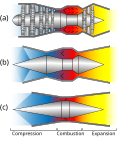Scramjet
A scramjet (supersonic combustion ramjet) is a special type of ramjet jet engine where fuel combustion takes place while the air in the engine is moving faster than the speed of sound.[1] In a ramjet, air is slowed to subsonic (slower than the speed of sound) speeds before fuel is burned. Unlike ramjets, scramjets do not use shock cones to compress incoming air; instead, shock waves from inside the engine compress the air by slowing it down very quickly. This means that scramjets can operate very efficiently at extremely high speeds. However, a scramjet relies on the aircraft moving much faster than the speed of sound in order to work; scramjets do not work at subsonic, or even low supersonic, speeds.
As of November 2022, scramjets are still experimental. This means that they have not been used on commercial airliners or in active military scenarios. Successful scramjet tests have been conducted, however.
Advantages and disadvantages
Advantages
- Does not need to carry oxidizer
- No complex parts makes it easy to build
- Has a higher specific impulse than a rocket engine
- Could provide easy access to space in the future due to high top speed
Disadvantages
- Difficult and expensive testing/development
- Needs a separate engine to get it up to speed
Scramjet Media
Artist's conception of the NASA X-43 with scramjet attached to the underside
Computational fluid dynamics (CFD) image of the NASA X-43A with scramjet attached to the underside at Mach 7
Test of Pratt & Whitney Rocketdyne SJY61 scramjet engine for the Boeing X-51
References
- ↑ LaRC, Bob Allen. "NASA - How Scramjets Work". www.nasa.gov. Archived from the original on 2022-12-02. Retrieved 2022-11-03.






